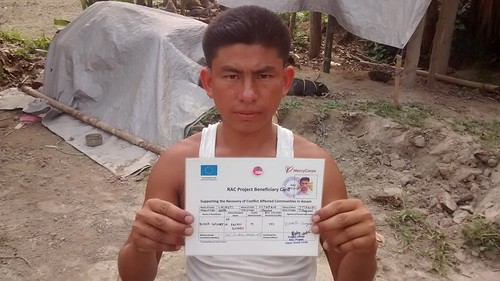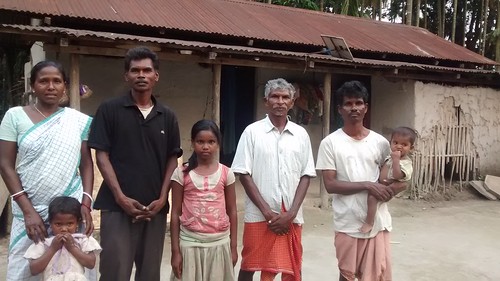By Amit Kumar, TwoCircles.net
Chirang: William Tudu, a 60-year-old Santhal, is not sure who to vote for. He has been voting in the past elections too, hoping that one of these days, some leader might pay attention to their plight. But given that the front runner in Sidli Chirang constituency is a leader of Bodoland People’s Front, he says it is unlikely that much will change for the Santhals in the near future.
Chirang, one of the four districts of the Bodoland Territorial Area Distrcts (BTAD), has been peaceful of late, but it remains on tenterhooks given its violent and bloody past. This area has been seen unrest since the 90s on account of demands of a sovereign state by a section of the Bodos and as a result people from all communities have been internally displaced. Most of the people have had no option but to simply clear forest land and settle at places close to the water bodies.

December 2014 violence: 18 months later, no closure for locals
Romeshwar Basumatary remembers the afternoon of December 26. The area around his village Militha had been on high alert after the insurgent group–National Democractic Front of Bodoland (Sonbijit)–had attacked and burnt down the houses of Santhals. Basumatary, who is a Bodo, knew that there was a chance that the Santhals might attack their village and his fears were right. On December 26, about 30-40 Santhals attacked the Bodo village and burnt down close to 15 houses. Basumatary now lives a kilometre away from his previous residence; the remains of his previous house still visible from the courtyard of his new house. “The Santhals had attacked us in retaliation to the NDFB attacks. I know the Santhals who live in this area and I could barely recognize one or two persons, so I can safely say that most of them were from far-off areas,” he adds. He has no grudge against the local Santhals and blames the Bodo political forces for the unrest. “We stayed in the Laimuthi relief camp for about three months and it took us nearly a year to rebuild our houses. How can they (NDFB) claim to be fighting for Bodos when we are also at the receiving end of their violence?” he asks.
According to Militha village head Sukur Basumatary, the political leadership failed the Bodos as they did not even provide basic compensation to the affected people. “When we were at the camp, I had asked the district administration to provide us compensation as all the parties had lost a lot of provisions like rice and some livestock in the fire. However, the administration refused to even acknowledge that we were displaced as the relief camp was only 3 kms from the village and we had been there only for a few months,” he said. The only financial help that the families received was an amount of Rs 5,000 from a collective of NGOs. This amount, received in March 2015, remains the only compensation that they have received till date. Binod Guiari, who lost his house and around 100 kgs of rice, says that unless the leadership focuses on curbing the insurgents, there is little chance that they will not get displaced again.

For the Santhals, this period was more, if not equally, dangerous. Brought to Assam by the British to work in tea estates and the forests, they have been settled in this area and other parts of Chirang and Kokrajhar for around a century, but at least in Chirang, even finding their village can be nigh impossible for an outsider. From the Runikatha police station, one has to walk about 5 kms and cross two make-shift bridges to reach the Bodo village. From there on, to go to the Santhal village one has to walk a further 3-4 kms through mud tracks and cross two shallow streams, apart from hoping that a local tells you exactly which path to follow, to reach the first Santhal village called Ranipur. The village, which is home to 32 Santhal families, has homes on both sides of the river Laopani and the next Santhal village, Dordhora, is about a kilometre away. There is of course, no electricity, no water supply; the closest medical facility is in Runikhata and the closest school is also about 4 kms away. Worryingly, this means that the Santhal villages are mostly inaccessible every time it rains; the mud tracks and the streams make it impossible to visit and leave the village. For resident Nicholas Soren, however, these factors pale in comparison to the constant threat to their lives. “What happened in December was just one more incident in a long list of atrocities that we have faced here. More than 70 families in Ranipur, Dordhora, and other Santhal villages were burnt and eight people died. Thousands were displaced and we were spread across four temporary camps in Mainagudi, Salbari, Kadamguri, Japaitola and stayed there for the whole of 2015,” he says. For Soren, who had to leave his ancestral village Kunthalmuri about 10 years ago after it was attacked, the fear of displacement overshadows any hope he has from the coming elections. “Not a single leader from any party has visited us to even ask for votes, let alone listen to our needs. Yes, I will vote but I don’t expect that to change much”, adds Soren.

Bimal Tudu, another resident of Ranipur, says he is lucky to be alive. “The NDFB insurgents wore uniforms similar to the Army. They were shooting and I, along with some other people were running like crazy. We were at the crossroads between Balamguri and Dordhora and out of instinct, I entered someone’s house. The guy behind me kept running and was shot. He died on the spot,” he says. Tudu added that while some of the families were paid a monetary compensation of Rs 50,000 by the Assam government, but the lack of political figures among Santhals means that even today, the threats they face remain as strong as ever.
Lack of dialogue adds to distrust among communities, helps political leaders
While both Bodos and Santhals, along with Assamese, Nepali and Bengalis have existed with each other in this area for a long time, there is a clear lack of dialogue at the community level. William Tudu, who is the village head of Ranipur, says that post 2014 attacks, whatever little interaction that existed on a personal level between the communities is now over. According to Sukur Basumatary, prior to the December 2014 incidents some of the Santhals used to find jobs as daily labourers in the fields owned by Bodos during the harvesting season. “Now, they won’t even do that as they are scared,” he says.
Tudu says that the lack of dialogue makes it easier for political parties to keep them divided. “We are still seen as outsiders,” he says. He added that the Santhals take a longer route to go to Runikhata because the shorter route goes through a Bodo village.

The result of internal displacement has also benefited the political and insurgent forces financially. The displaced people have no option but to clear forest land, which opens up more areas for the lumber industry. The encroachments are right in areas that were dense forests until about 10 years ago. “Earlier, the entire area from Runikhata to the Indo-Bhutan border (30 kms) was forests. But now a massive area has been cleared and this is helping the businessmen make big money. Also, this helps the insurgents make a lot of money,” said a Bengali shopkeeper near the Runikatha police station. “Displacement is good for business,” he added.

